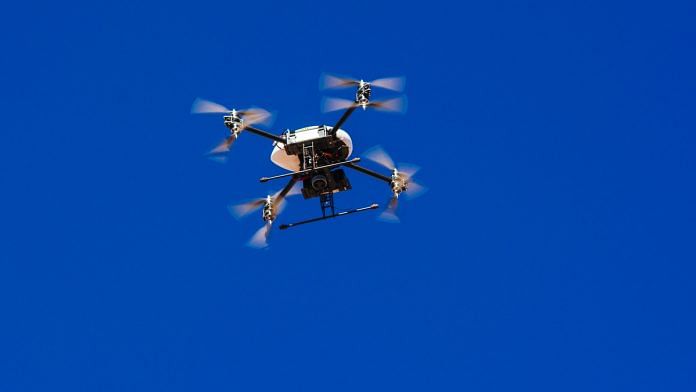It is a matter of time before terrorists use drones to launch attacks in Jammu and Kashmir, the northeast, the Red Corridor and the hinterland of the country. India is virtually defenceless against drone terrorism and is doing little to gear up despite warning signals from across the world.
Two unusual attacks in recent months, carried out by commercial off-the-shelf drones laden with explosives, did not get much attention from the Indian media and the security establishment.
On 4 August 2018, the President of Venezuela, Nicolãs Maduro, was allegedly targeted during a military ceremony in Caracas when two low-flying drones exploded, causing the soldiers in the military parade to flee and leading to a stampede-like situation. At least half a dozen National Guard soldiers were injured in the attack.
The second such attack took place 10 January 2019 when an explosives-laden drone, allegedly flown by Houthi rebels, flew into a military parade in Yemen killing at least six soldiers.
Also read: Dear General Bipin Rawat, this is what is wrong with your military reforms
How terrorists can use drones
Globally, an estimated 100 drone sightings are reported by pilots of manned aircraft every month. Drones are now reportedly being used by the ISIS, Hezbollah, Houthis and militant groups in Ukraine extensively.
Terrorists are known to wage an asymmetric war and are quick to exploit emerging technologies – drones now add a new dimension to terrorism.
Commercial off-the-shelf (COTS) drones are small, cheap and easy to conceal. Military drones are heavier and expensive but can be made available to the terrorists by the sponsoring states. DIY manuals are available on the Internet and so are the drone components.
Armed with explosives and electronic packages, drones can be used by terrorists for following missions:
- Intelligence, surveillance and reconnaissance (ISR) of targets and security forces.
- Trans-border transportation of weapons, explosives, narcotics and currency.
- Assassination of political leaders, targeting military/police personnel and individuals.
- Targeting commercial aircraft/helicopters.
- Attacking crowds at political rallies, religious gatherings, markets and sports stadiums to cause casualties and stampedes.
- Chemical, biological and radiological attacks.
- Targeting electricity grids.
- Causing fire at fuel depots.
- Causing train and bus accidents.
Defence in depth response
The defence against drone attacks covers the entire gamut of ‘defence in depth’ response, which includes prevention, deterrence, denial, detection, interception and destruction. Prevention is, of course, based on good intelligence, but the lacunae in terms of lack of a National Counter Terrorism Centre and a National Intelligence Grid are well-known.
Also read: Submarine-launched drones, combat UAVs, aircraft carrier part of India’s future buy list
On deterrence, the ministry of civil aviation has done well to lay down the regulations for Remotely Piloted Aircraft Systems (RPAS) through a Digital Sky Platform, effective 1 December 2018. This is a first-of-its-kind national unmanned traffic management (UTM) platform that implements a ‘no permission, no take off’ policy.
While preventive measures have been put in place to keep a tab on drones produced in India and those officially imported, the provisions in the law – IPC Section 336 deals with an act endangering life or safety of other persons – are inadequate to deal with the violations.
The aspect of ‘denial’ has been covered in the regulations under ‘no permission, no take off’ and ‘return to home’ systems, and no-fly zones have been and can be specified on as-required basis. In due course, ‘geo fixing’ – a coded pre-established boundary – can be introduced as well. Needless to mention that terrorists will devise ways to bypass the regulations and smuggle drones that do not have electronic checks in place. Also, legitimate drones can be hijacked by terrorists.
The aspects of detection, interception and destruction of micro, mini and small-sized drones are a grey area and foolproof solutions are still being developed. The military measures are only effective against medium and large-sized drones as the radar signature of small drones is not visible. Further, the military cannot cover the hinterland. Drone-specific radars are in the works as also acoustic, image and infrared detection systems.
Also read: Home-grown terror is India’s bigger challenge, and no one’s talking about that
The military way of neutralisation/destruction is ineffective against small drones. Radio frequency and GPS jammers are an effective electronic neutralisation tool. Low-calibre, anti-drone missiles and guns are being developed. Manning of detection, interception and destruction equipment to cover the vulnerable points/areas in the hinterland will have to be done by the police or paramilitary.
Time is running out, and the government needs to get battle-ready to counter the threat of drone terrorism. The 26/11 attacks happened because we failed in preparing for sea-borne threats. We must not allow a repeat of such an event in India.
Lt Gen H S Panag PVSM, AVSM (R) served in the Indian Army for 40 years. He was GOC in C Northern Command and Central Command. Post retirement, he was Member of Armed Forces Tribunal.




All monies for socialist welfare, no money to fight drone terrorism.